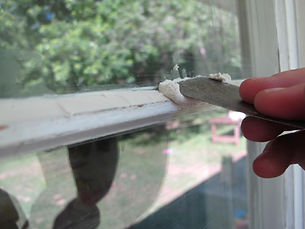Fixing air leaks and seal windows. Image obtained from: DIY Network. Click on image for reference.
Putty for sealing an gaps or leakages
A minor retrofit to your home could include adding a putty-like substance, which is a glazing compound, to your windows in order to prevent energy loss and cold air from coming in. This glazing compound essentially acts as a seal, which can cover any gaps and/or leakage. When using the putty-substance, you will often have to remove the old putty, and then replace it with the new one bought. There are various brands of putty available, we recommend that you look at your local hardware store and talk to the store assistant to get further instructions on how to use the putty and find one that best fits your budget. You are also able to paint the putty after it is completely dry if you choose to do so.
On an additional note, please be careful when handling the glazing compound, we are not responsible for any damage or harm if there are any.
Glazing - Putty
Glazing can be used to control glare, heat gain, weather resistance or even increase privacy. It is not a complicated process, first you need to have the glazing compound (putty-like substance) and a putty knife. Remember that when glazing a window, you will often have to remove the old putty and then replace it with the new putty. There are different types of putty that can be used for glazing, and the most common ones are the hard linseed oil putty, modified oil-typing glazing compounds and acrylic glazing compounds. Depending on what base you use for glazing, it can vary the time it takes to dry.

Blinds
Adding some sort of covering to your windows is another great way to conserve energy, get natural light in your home and for privacy purposes. There are several types of coverings available, one of them are blinds. They can come in either vertical-slates or horizontal-slates. Although they may not be sufficient to keep heat in during colder temperatures, they are able to keep heat out during warmer seasons. The slates of the blinds can come in various materials/colors which can fit the aesthetic of your home. Highly reflective blinds can reduce heat transfer into the home.
Putty, a glazing compound, being applied to the window pane. Image obtained from: Family Handyman, click on image for reference
Blinds. Image obtained from Wix.
Cellular Blinds (Interior Insulating Blinds)
Interior Cellular Blinds are blinds that creates a thermal shield for your home. They are slightly more expensive than regular blinds, but they will help you save on energy loss. They are made of a lightweight fabric and use an accordion fashion to open and close. When fully extended, a honeycomb-like structure forms a thermal shield between the cold window and your warm interior.
Cellular blinds. Image obtained from: Zebra Blinds, click on image for reference.
Window film showing the layers making up a typical product. Image obtained from: Minnesota Department of Commerce, click on image for reference.
Surface Applied Window Films
Window films can be applied to the surface of the glass of a window in order to change its optical properties. It can be applied on the inside or outside; interior application is required to save heating energy and external application is required to save cooling energy. These films should not be confused with the seasonal shrink wrap type of plastic sheeting such as "3m indoor window insulator kit," these kits are a temporary version of the window films. The lifetime of window films is between ten and twenty years. They are made of multiple layers of plastic materials. Here is an example of such window films: 3M Daylight Reflecting Film.
1. Kukun Home Intelligence (January 20 2020), Window Glazing. Retrieved from: https://blog.mykukun.com/window-glazing-complete-guide/
2. US Department of Energy (n.d), Energy Efficient Window Attachments. Retrieved from: https://www.energy.gov/energysaver/energy-efficient-window-attachments
3. The Spruce (January 16 2020), Retrofit Windows. Retrieved from: https://www.thespruce.com/retrofit-windows-can-save-money-1822932M
4. Minnesota Department of Commerce Division of Energy Resources (March 2015), Window Retrofit Technologies. Retrieved from https://www.mncee.org/getattachment/Resources/Projects/Window-Retrofits-Increasing-Window-Efficiency-Wit/Window-Retrofit-Technologies-Final-Report.pdf.aspx



